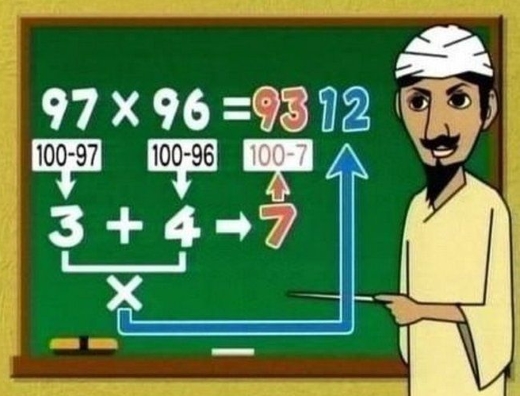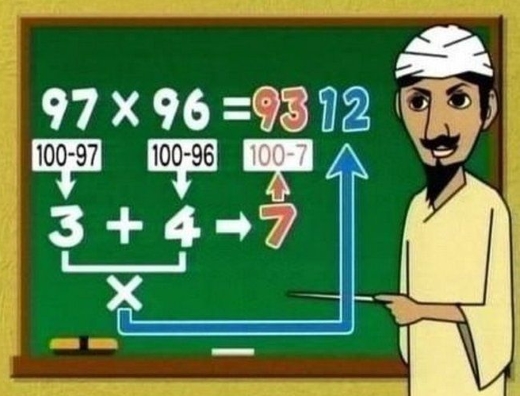Pure mathematics is, in its own way the poetry of logical ideas.
Albert Einstein
In this article we offer you a selection of simple mathematical techniques, many of which are quite useful for everyday life and suggest to calculate faster.
1. Quick calculate of percents
Perhaps, in the age of credit and installments most relevant mathematical skills can be called masterly calculation of percents in mind. The quickest way to compute a certain percentage of the number is a multiplication of the percentage of this number, followed by dropping the last two digits to get a result, because the percent is a one-hundredth part of a number.
What is 20% of 70? 70 × 20 = 1400. Discard two zeros and you’ll get 14.
This method is very simple in the case of round numbers, but what if you need to calculate, for example, the percentage of the number 72 or 29? In such a situation will have to sacrifice accuracy for speed and round number (in this example, 72 is rounded up to 70 and 29 to 30), and then use the same reception with multiplication and dropping the last two digits.
2. A quick check divisibility
Can I divide 408 sweets equally between the 12 children? To answer this question easily and without a calculator, if you remember the simple signs of divisibility that we were taught in school.
- A number is divisible by 2 if its last digit is divisible by 2.
- The number is divided by 3, if the sum of numbers that make up the numbers divisible by 3. For example, take the number 501, present it as a 5 + 0 + 1 = 6. 6 divided by 3, and therefore, the number itself is divided into three 501 .
- A number is divisible by 4 if the number formed by its last two digits is divisible by 4. For example, take 2 340. The last two digits form the number 40, which is divisible by 4.
- A number is divisible by 5, if the last digit is 0 or 5.
- The number is divided by 6 if it is divisible by 2 and 3.
- Number is divisible by 9, if the sum of numbers that make up the numbers divided by 9. For example, take the number 6390, will present it as a 3 + 6 + 9 + 0 = 18. 18 is divided into nine, and hence the number itself 6 390 is divisible by 9.
- The number is divided by 12 if it is divisible by 3 and 4.
3. Quickly calculation of square roots
The square root of 4 is 2. It is clear. And what about the square root of 85?
For a quick approximate solution closest to a given square number, in this case 81 ^ 2 = 9.
Now we find the next closest square. In this case, 100 = 10 ^ 2.
The square root of 85 is somewhere in the range between 9 and 10, since 85 is closer to 81 than to 100, the square root of this number will be 9 with something.
4. Fast computation of time through which the financial contribution by a certain percentage will double
Want to find out quickly the time it will take to get your financial contribution to certain interest rate doubled? There’s also no need to take a calculator, it is enough to know “rule of 72”.
Divide the number 72 on our interest rate and then get an approximate period through which contributions will be doubled.
If the contribution is made at 5% per annum, it would take 14 years or so to be doubled.
Why 72 (sometimes take 70 or 69)? How it works? These questions are deployed to answer “Wikipedia”.
5. Fast computation of time through which the financial contribution by a certain percentage will triple
In this case, the interest rate on the deposit should be a divisor of 115.
If the contribution is made at 5% per annum, it would take 23 years to it tripled.
6. Advanced Mathematics on the fingers
Your fingers are capable of much more than the simple addition and subtraction.
Using your fingers you can easily multiply by 9, if you suddenly forget the multiplication table.
Enumerate fingers from left to right from 1 to 10.
If we want to multiply 9 by 5, the fifth finger on the left hand should be folded.
Now look at your hands. It turns out that there’re four unfolded fingers before folded. They represent dozens. And five unfolded fingers after folded. They denote units. Answer: 45.
If we want to multiply 9 by 6, fold the sixth finger on the left. We’ll have five fingers unfolded before folded and four after it. Answer: 54.
Thus it is possible to reproduce the entire column multiplication by 9.
7. The rapid multiplication by 4
There is a very easy way of lightning multiplying large numbers even byat 4. It is sufficient to expand the operation into two steps by multiplying the required number by 2, and then again at 2.
See for yourself. Multiply 1223 by 4 in mind not everyone can. And now we do 1223× 2 = 2446 and then 2446 × 2 = 4892. So much easier.
8. Quickly determine the minimum necessary
Imagine that you are going through a series of five tests for the successful completion in which you need a minimum score of 92. There remains the last test, and on the previous results are the following: 81, 98, 90, 93. How to calculate the required minimum, you want to get in the last test?
To do this, count how many extra points we’ve gained or how many points we haven’t gained to required 92.
Thus, 81 – 92 = -11; 98 – 92 = 6; 90 – 92 = -2; 93 – 92 = 1.
Adding these numbers, we obtain an adjustment to the minimum necessary: -11 + 6 – 2 +1 = -6.
It turns out the deficit in 6 points and, therefore, you should gain at least 92 +6 = 98.
9. Rapid representation of the common fraction
Estimated value of the common fractions can be quickly represented as decimal if pre bring it to the simple and straightforward relations: 1 / 4, 1 / 3, 1/2 and 3/4.
For example, we have a fraction of 28/77, which is very close to 28/84 = 1/3, but since we have increased the denominator, the original number will be slightly more, that is a little more than 0.33.
10. Trick guessing numbers
You can play a little in the role of David Blaine and impress your friends by interesting, but very simple mathematical trick.
- Ask a friend to think of any integer.
- Let him/her multiply it by 2.
- Then let him/her add to the result 9.
- Now let him/her substract 3 from the resulting number.
- And now let him/her bisect the result.
- Finally, ask him/her to subtract from the resulting number the number, which he/she set in the beginning.
The answer will always be 3.
Yes, very stupid, but often the effect exceeds all expectations.
Bonus
And, of course, we could not to insert into the post that same picture with a very cool way of multiplication.


![hqdefault[1]](https://fabweb.org/wp-content/uploads/2015/09/hqdefault1.jpg)











